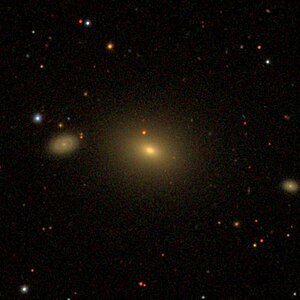NGC 76
| Galaxie NGC 76 | |
|---|---|
 | |
| SDSS-Aufnahme von NGC 76 & MCG+05-01-073 (li.) | |
| AladinLite | |
| Sternbild | Andromeda |
| Position Äquinoktium: J2000.0, Epoche: J2000.0 | |
| Rektaszension | 00h 19m 37,8s[1] |
| Deklination | +29° 56′ 02″[1] |
| Erscheinungsbild | |
| Morphologischer Typ | E/SA0?[1] |
| Helligkeit (visuell) | 13,0 mag[2] |
| Helligkeit (B-Band) | 14,0 mag[2] |
| Winkelausdehnung | 1′,0 × 0′,9[2] |
| Positionswinkel | 65°[2] |
| Flächenhelligkeit | 12,7 mag/arcmin²[2] |
| Physikalische Daten | |
| Zugehörigkeit | LDCE 12[1] |
| Rotverschiebung | 0.024440 ± 0.000067[1] |
| Radialgeschwindigkeit | (7327 ± 20) km/s[1] |
| Hubbledistanz H0 = 73 km/(s • Mpc) | (335 ± 23) · 106 Lj (102,7 ± 7,2) Mpc [1] |
| Durchmesser | 95.000 Lj[3] |
| Geschichte | |
| Entdeckung | Guillaume Bigourdan |
| Entdeckungsdatum | 22. September 1884 |
| Katalogbezeichnungen | |
| NGC 76 • UGC 185 • PGC 1267 • CGCG 499-111 • MCG +05-01-072 • 2MASX J00193779+2956017 • | |
NGC 76 ist eine elliptische Galaxie vom Hubble-Typ E-S0 im Sternbild Andromeda am nördlichen Sternenhimmel. Sie ist etwa 335 Millionen Lichtjahre von der Milchstraße entfernt und hat einen Durchmesser von ca. 95.000 Lichtjahren. Bei der etwa 25 Millionen Lichtjahre weiter entfernt gelegenen Zwerggalaxie PGC 1266 könnte es sich um einen Begleiter handeln.
Sie wurde am 22. September 1884 von dem französischen Astronomen Guillaume Bigourdan entdeckt.[4]
Weblinks
Einzelnachweise
Auf dieser Seite verwendete Medien
Autor/Urheber: Sloan Digital Sky Survey, Lizenz: CC BY 4.0

Angle of view: 4' × 4' (0.3" per pixel), north is up.
Details on the image processing pipeline: https://www.sdss.org/dr14/imaging/jpg-images-on-skyserver/